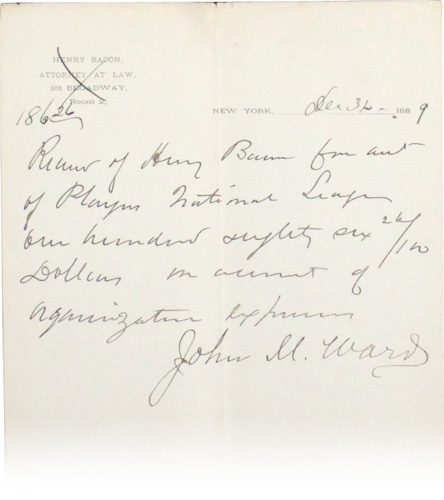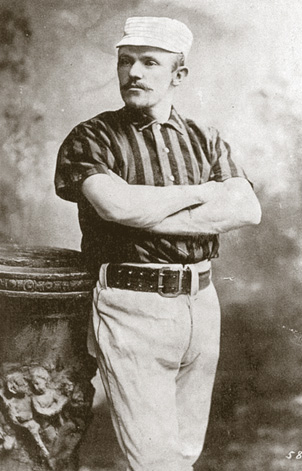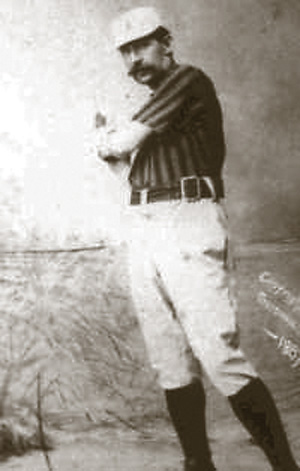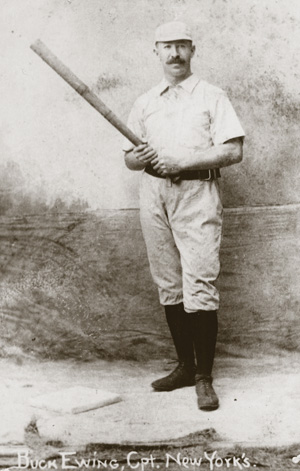1890's Player's League Historical Signed Documents


John Montgomery Ward

Tim Keefe

Buck Ewing

Extremely rare signatures of HOF icons, Tim Keefe, Buck Ewing and John Montgomery Ward.
Extraordinary and Unique Players' League Articles of Agreement, Constitution and By-Laws.
Document relating to the merger of the NY Players' League & NL Giants.
Signed Documents detailing the sale of the Cincinnati NL Franchise to the Players' League.
It is with distinct pleasure that Memory Lane now brings to light one of the most miraculous memorabilia discoveries experienced by our illustrious hobby. Proudly dubbed 'The Northeast Find", a significant number of unique documents relating to the by-gone 1890 Players' League were brought to our attention earlier this year by our esteemed consignor; rescued from a desolate New York-based building's storage room decades ago. Unquestionably, no memorabilia offering conjures up the excitement and/or fascination of a newly unearthed artifact(s), and considering its "one of a kind" stature, we are sure that the vast array of documents presented as separate lots in this auction will capture the hearts of a myriad of elite hobbyists.
The Players' League represents a momentous time in our National Pastime's glorious history; proudly standing tall as the inaugural player's revolt against team management. Led by legendary Hall of Famer John Montgomery Ward, many National League and American Association players pleaded to be treated in a more equitable manner; eventually jumping ship for equality purposes to formulate eight new teams in the one-year 1890 Players' League. The seemingly infinite number of noteworthy artifacts includes a staggering six separate documents carrying the near impossible to find Tim Keefe signature (three are offered in this auction), of which one amazingly includes a likewise scarce Buck Ewing autograph on the same document!
Not to be outdone, also unearthed in this discovery are 3 ultra-rare John Montgomery scripted notes (two presented in this auction); a Buck Ewing signed telegram; extensive Player's League "Constitution" and "By-Laws", three signed documents specifying details for team agreements with the League; an array of construction cost related papers for Brotherhood Park (more commonly known as the Polo Grounds); a letter of resignation for the New York Brotherhood Club, and so much more.
Unlike the highly publicized "Laws of Baseball" documents that sold for a staggering $3 million+ as a single lot in 2016, we have ultimately decided to separate this remarkable find into various lots, providing the collecting community a once in a lifetime chance to secure at least one of these highly historical relics. As previously stated, the 1890 Players' League represented a significant moment in baseball history, preceding the Federal League and a professional baseball player's eventual challenge to the "reserve clause" (spearheaded by Cardinal's outfielder Curt Flood) that eventually led to "free agency" and the expulsion of the owner's once tightly secured grip on player's rights. In order to have a clear understanding of its unparalleled significance, we feel the necessity to provide you with a thorough account of the history behind the 1890 Players' League, with the following historical account elaborating on its chronological evolution that will echo for eternity!
The post-Civil War period was a turbulent time in the United States. The industrialization of the country, which had begun slowly at the start of the century, picked up extensive speed with widespread hand labor being quickly replaced by machines. This industrial activity was primarily concentrated in cities, leading to a population flow from the country to these urban areas. The hand laborer became the factory worker. Society began to be divided into two camps; either a man was labor or he was management. Management sought to maximize profits through the efficient use of its' raw materials and labor, and this ultimately resulted in labor being forced to work long hours, in poor conditions, for low wages, leading to severe unrest and revolt.
What was happening across America, not surprisingly, was also evolving in baseball. This "grand ole game"started as a sport primarily controlled by the players; it was a recreation not a business. This all changed in 1876 with the folding of The National Association of Professional Baseball Players (NA), and the establishment of The National League of Professional Baseball Clubs (NL), with a momentous significance in the names of these two leagues. The formation of the NL represented a shift in power from the player and team to that of a central (owner controlled) governing body. This would allow more domination by management over labor, one of the business's few controllable costs.
In 1885, spearheaded by John Montgomery Ward who along with being a standout ballplayer was a formidable attorney (graduating from Columbia Law School in 1885), the first baseball player labor union titled "The Brotherhood of Professional Baseball Players" was formed. Ward was elected president, and Tim Keefe secretary-treasurer (thus explaining why their signatures would be abundant among these historic documents). Ward sought to protect the rights of the players and to raise player's salaries. This made sense since the game's popularity and revenue streams were increasing, yet the League had just passed a new (and arbitrary) $2000 player salary cap. The union also sought to overturn the reserve clause, a League rule which restricted player movement, and thus their ability to negotiate a fair wage. The union also objected to the system whereby players could be sold from one club to another like mere sheep.
While Ward was abroad as part of the 1888-89 Spading World Tour, the NL owners instituted the Brush Classification System, a set of rules which grouped players into several pay categories based on their performance both on and off the field. Players situated in the lowest salary tier were paid less that $1500 per year and were required to perform menial tasks such as manning the turnstiles and sweeping up stadium floors after a game. When informed of this, Ward left the Tour early and returned home and passionately attempted to combat this rule. Unfortunately, there was little that he could do which led to a further deterioration in the relationship between the players and the League. The Brotherhood now strongly believed that management cared little for the player's rights, and thus that it was time to act.
On July 14, 1889, not coincidentally Bastille Day, at a meeting of the various team Brotherhood chapters at the Fifth Avenue Hotel in New York, it was decided that each chapter would try to raise capital in its' own city to finance the formation of a "Players' League"for the upcoming 1890 season. Fund raising efforts proved successful key capital contributors, (called "backers") including Albert L. Johnson, a Cleveland trolley car line owner, Edward Talcott, a lawyer and stockbroker, Edwin McAlpin, a New York tobacco manufacturer, Cornelius Van Cott, a New York politician, Wendell Goodwin, a realtor, and John Addison, a Chicago contractor.
Also investing in the franchises were the players themselves. For the New York club, Talcott and McAlpin were the major financiers with Tim Keefe and Buck Ewing the player representatives to the club's board of directors. These are extremely noteworthy individuals in the eventual design of the 1890 Players' League, justifying why many of their scripted documents are included in this sensational discovery. On November 6, 1889, at a meeting at the Fifth Avenue Hotel, a public announcement of the formation of "The Players' National League"(PL) was made.
However, until each of the eight-member teams signed the Articles of Agreement, the official document forming the league on December 17, 1889 (also included in this discovery), the League was not a legal entity. The affairs of the new League, which up until this point had been under the guidance of the union, were turned over to those club representatives who made up the Board of Directors of the PL. The fundamental tenet of the new League was the fair treatment of the players (e.g., no player could be transferred from one club to another without his consent and never for monetary consideration, and player compensation would be more fairly determined).
The PL was organized as an association comprised of eight teams, duly organized or incorporated under the laws of their respective states, representing the cities of Boston, New York, Brooklyn, Philadelphia, Buffalo, Cleveland, Pittsburgh and Chicago. Each team, with the exception of Buffalo, would compete directly against a NL counterpart. The PL was governed by a "Constitution" (its statement of existence, basic rules, and purposes); "By-Laws"(elaborating the rules that governed its' operations); and "Playing Rules" that governed its actual play (incredibly, original drafts of the Constitution and By-Laws are likewise included as separate lots in this auction). Though the NL, led by Albert Spalding, tried to use the courts to prevent players from joining the PL, their efforts were largely unsuccessful. All told, all but twenty-five NL players joined the Players' League.
While the turmoil of the player exodus from the NL was throwing their 1890 season into a state of flux, the American Association (AA), the third strongest league of the time, was having its' own problems with an internal power struggle splitting the owners into two camps. This came to a head when on November 13, 1889, Brooklyn and Cincinnati owners Charles Byrne and Aaron Stern announced that they were exiting the AA. By the end of November, both the Kansas City and Baltimore franchises had followed suit. Over the winter, the NL took the opportunity to strengthen itself by ousting the weak sister Indianapolis and Washington clubs and adding the newly free Brooklyn and Cincinnati teams. Ironically, with the ousting of Indianapolis, owner John Brush, the author of the salary limitation plan that had contributed to the formation of the PL, was gone from the majors. The hole created in the AA by the departure of these four teams was filled by the addition of three minor league teams from the International League (Syracuse Stars, Rochester Hop Bitters, Toledo Maumees) and a newly formed Brooklyn franchise, the Brooklyn Gladiators.
Despite the efforts of the NL owners to kill the PL before play began, both Leagues completed the 1890 season, and unfortunately, each league experienced severe financial struggles. Veteran scribe Henry Chadwick estimated that the NL and PL, in aggregate, had lost roughly $500,000. Both Leagues drew poor attendance with current calculations having the PL drawing some 900,000 patrons while its' established counterpart drew about 850,000. The AA suffered even more and, following the 1891 season, would ultimately collapse.
As the 1890 season progressed, the PL backers surely questioned their decision to finance the new League. As early as July, there had been stories in the press about a possible compromise or consolidation of the two Leagues, but no consensus could be reached. Following that inaugural 1890 season, a major victory for the PL, albeit its' last, took place. On October 4, 1890, a group of PL representatives (Albert Johnson, Edward Talcott, John Ward, and Frank Brunell) purchased the Cincinnati NL franchise from Aaron Stern and Harry Sterne for the mere sum of $40,000. Their intent was to have Cincinnati replace the failing Buffalo franchise for the upcoming 1891 PL season. This, however, proved to be the PL's last hurrah. Starting later in October, a series of meetings (some formal, some not) were held between NL and AA representatives, led by Albert Spalding, and PL backers.
Significantly, all players, even though they were supposedly "equal"partners with the backers, were excluded from the meetings. Spalding portrayed the NL's financial circumstances as being rosier than they actually were and the PL backers fell for his rhetoric. Slowly but surely, owners of some of the PL franchises began to lose their original resolve. The franchises in New York, Brooklyn and Pittsburgh agreed to merge with their NL counterparts. On November 13, 1890, the Chicago Pirates owner John Addison sold the Pirates to Albert Spalding. For a while, the PL harbored thoughts of pressing on as a smaller fourteam League, but this proved unworkable. The grand experiment folded with only one season under its' belt with the Boston and Philadelphia franchises moving to the AA for the 1891 season, and Philadelphia replacing the prior insolvent Philadelphia club. Finally, the newly acquired Cincinnati franchise ended up being sold and moved back to the NL.
Though its' story has somewhat faded with the passage of time, the 1890 Players' League represented the most significant challenge the NL had ever faced. If not for the capable leadership of Albert Spalding, the NL and all of baseball just might reflect a totally different look today. It is for all of the aforementioned history why these newly discovered documents represent such a critical point in our National Pastime's history. Although somewhat forgotten over the past 127 years, its rather obscure existence truly suffices as a bonafide testament for America's fundamental principals as they relate to "equal rights", so duly noted within the Declaration of Independence and Constitution constructed by our Founding Fathers in the latter part of the 18th century.
To reiterate, the next 17 lots all provide the true enthusiast with some level of significance for this long-gone League, with some of the lots representing virtually impossible to find autographs of immortal Hall of Famers Tim Keefe, John Montgomery Ward and Buck Ewing. In fact, before this world-class discovery we had known of only two prior Tim Keefe signatures extant (to the best of our knowledge), with Keefe's autograph a near-impossible script to fill the void of any Hall of Fame collection (as well as Ward and Ewing). The hobby is currently experiencing an exciting trend of some of the most sensational collectibles ever offered to the public including last year's "Laws of Baseball" and the recent sale of Jackie Robinson's original 1947 Dodger's contract.
Similar to other historic hobby finds such as the E98 "Black Swamp", the 1952 Topps "High- Numbers" and the "Lucky 7" Ty Cobb T206 Ad Back, this spine-tingling array of Players' League lots turns back the clock, transcending time to an era when baseball itself was exercising its initial revolt against ownership's seemingly impervious control of player's rights. Virtually any baseball history of this period would indicate that the Players' League was formed to provide for more equitable treatment of the player relative to the way he was treated in the National League.
However, how was this to be accomplished? How would the rules governing players be altered? Well, courtesy of this worldclass discovery, we now know. Amongst these documents are what are believed to be the first known copies of the Players' League Constitution and By-Laws, as well as the Articles of Agreement, the document that created the Players' League. It was already known that John Ward had leased the land upon which the New York Player's League entry, the Giants, were to build their home stadium, Brotherhood Park.
This stadium, after the Players' League folded, was rechristened as the legendary Polo Grounds and became the home of the National League Giants for the next sixty-seven years. We knew Ward leased the land, but the terms of the lease were just speculated about, often incorrectly. Now, with the discovery of a draft of this very lease, we know the details as well as being able to "fill in the blanks" for a vast amount of ambiguity previously residing from other aspects of the 1890 Players' League.
These documents and more, some adorned with the aforementioned extremely rare autographs of John Ward, Tim Keefe, and Buck Ewing, compose this amazing find with a summary of the key components as follows:
In order to create a streamlined "story" of the Players' League on-going evolution, the following documents/lots have been presented in chronological order, with the next page providing a "Table of Contents" for all 17 lots. A golden opportunity to capture at least one of these "unique" artifacts, we invite you to become an integral part of this extraordinary moment in baseball history when professional baseball players instituted their inaugural effort for "equal rights"; eventually leading to the game as we know it today and the unequivocal principal our nation was soundly built on.